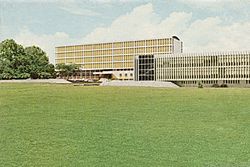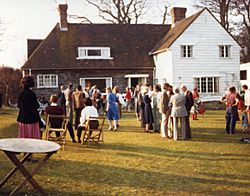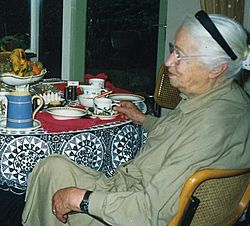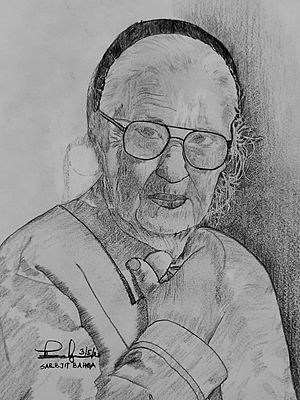Jane Drew facts for kids
Dame Jane Drew (born March 24, 1911 – died July 27, 1996) was a famous English architect and town planner. She was known for her modern designs. She studied at the Architectural Association School in London. Before World War II, she became a leader in the Modern Movement, a new style of architecture in London.
When Jane Drew opened her first office, she wanted to hire only women architects. This was unusual because architecture was mostly a job for men back then. She worked during and after World War II. She designed homes and public buildings in England, West Africa, India, and Iran.
With her second husband, Maxwell Fry, she designed schools and universities in West Africa. She, Fry, and Pierre Jeanneret also designed homes for Chandigarh, the new capital city of Punjab in India. She designed buildings in Ghana, Nigeria, Iran, and Sri Lanka. She also wrote books about what she learned from her work in these places. In London, she designed social housing and buildings for the Festival of Britain. She also helped start the Institute of Contemporary Arts. After she stopped working, she traveled and gave talks. She received many special awards. In 1996, just seven months before she died, she was given the special title of Dame Commander of the Order of the British Empire (DBE).
Contents
Life Story of Jane Drew
Early Years (1911–1928)
Jane Drew was born in Thornton Heath, Croydon. Her birth name was Iris Estelle Radcliffe Drew, but it was later changed to Joyce Beverly Drew. Her father, Harry Guy Radcliffe Drew, designed tools for doctors. He believed in helping people and hated cruelty. Her mother, Emma Spering Jones, was a teacher. When Jane was four, her mother had an accident and became lame for life. Her mother taught her daughters to love nature and art. Jane also had an older sister, Dorothy, who became a doctor.
Jane Drew went to Woodford School and then Croydon High School, where she was a top student. She was friends with famous people like actresses Peggy Ashcroft and Diana Wynyard, artist Barbara Jones, and women's rights activist Beatrice "Nancy" Seear.
Starting Her Career (1929–1939)
Jane Drew studied architecture at the Architectural Association School of Architecture from 1929 to 1934. In 1933, she married James Thomas Alliston, who was also an architect. In 1934, she started working with Joseph Hill. She also met many creative people in London who influenced her work.
Later, she partnered with her husband, Alliston. In 1937, they won a contest to design a small hospital in Devon. They had a small office and home at 24 Woburn Square in London. Their main work was designing homes in Winchester. Jane and James had twin daughters. Their marriage ended in 1939.
The Modern Movement
Jane Drew quickly became involved in the Modern Movement in architecture. This movement was guided by the famous Swiss architect Le Corbusier. Jane became one of the main founders of this movement in Britain. It was called MARS (Modern Architectural ReSearch). This group included architects, painters, and business people. They believed in designing buildings that were useful for human activity, not just pretty. Through this group, she met Le Corbusier, Elizabeth Lutyens, and Maxwell Fry. Jane married Maxwell Fry in 1942.
Designing Chandigarh with Le Corbusier
After seeing Jane Drew's projects in West Africa, the Prime Minister of India, Pandit Nehru, asked her and Maxwell Fry to design Chandigarh. This was a new capital city for Punjab. Jane was very busy with the Festival of Britain at the time and wasn't sure if she could take on such a big project.
Jane used her charm to convince the famous Swiss architect Le Corbusier to join the project. Le Corbusier was in charge of the city's main plan and important government buildings like the High Court and Assembly.
Working with Le Corbusier was sometimes hard. Jane said that even though he was great, he made mistakes. For example, his concrete sunshades sometimes made buildings hotter instead of cooler. Also, he initially wanted shopkeepers to live away from their shops, but Jane convinced him to let them live above their shops. Despite these challenges, they became good friends.
Jane, Pierre Jeanneret, and Maxwell Fry spent three years living and working in Chandigarh. Conditions were basic, and the heat was extreme. Le Corbusier only visited for two months each year during cooler weather.
Pandit Nehru wanted Chandigarh to be a model city for the many refugees coming from Pakistan. He wanted new designs and plans, not old traditions. Because of this, Jane, Fry, and Le Corbusier were able to include schools, health clinics, swimming pools, and outdoor theaters with the housing. All the homes had good bathrooms and water. Cheaper homes were built in rows, giving people bigger rooms and more safety for their money.
Before building many homes, Jane built sample houses. People lived in them, gave feedback, and then improvements were made. This helped Indians try new ways of living. Public green spaces were provided for all low-income housing. Rent was set so that people spent no more than a tenth of their income on housing. Keeping animals like buffaloes and cows was not allowed in the housing areas, as this had caused diseases. Indians learned that some of their old housing styles were not good anymore and were open to new ideas. The new housing designs in Chandigarh influenced home design all over India.
War Time Work (1939–1945)
Architecture was mostly a male profession back then. When Jane worked alone during the war (1939–1944), her office was at 12 King Street in London. At first, she hired only women architects, but this changed later. Her work during this time included:
- 1940: Walton Yacht Works near London.
- 1941: A Kitchen Planning Exhibition in London.
- 1941–1943: She advised the British Commercial Gas Association on designs "by women for women."
- 1943: The 'Rebuilding Britain' exhibition at the National Gallery in London.
- 1944–1945: She helped plan for the West African Colonies.
After the War (1946–1959)
After the war, Jane partnered with Maxwell Fry to form Fry, Drew and Partners. Later, others joined their firm. Their office was at 63 Gloucester Place, London. Jane and Fry also lived in a flat above the office.
- 1946–1950: She worked as Maxwell Fry and Jane Drew.
- 1946–1962: Jane was the first editor of the Architects' Year Book.
- 1946: The 'Britain Can Make It' exhibition at the Victoria and Albert Museum.
- 1948: Designed teacher training colleges in Ghana (with Maxwell Fry).
- 1949: Designed a hospital for the Kuwait Oil Company.
- 1949: Designed homes in Harlow New Town (with Maxwell Fry).
- 1950: Designed schools in Ghana (with Maxwell Fry).
- 1950: Designed Passfields flats in Lewisham, London (with Maxwell Fry).
- 1950: Designed the inside of the ICA (Institute of Contemporary Arts) in London (with Maxwell Fry and other artists).
- 1951–1958: Worked as Fry, Drew, Drake and Lasdun.
- 1951: Designed new school buildings and parts of the Festival of Britain (with Maxwell Fry).
- 1951–1953: Worked with Le Corbusier and Pierre Jeanneret on housing in Chandigarh, India. Jane convinced Le Corbusier to join the project. They worked with Indian architects on this huge project.
Other Important Projects
- 1953–1959: Buildings in Ibadan, Nigeria, including the University College (with Maxwell Fry), a bank, and an Assembly Hall.
- 1953: Flats in Lewisham, London (with Maxwell Fry).
- 1955: Housing for oil company workers in Masjid-i-Suleiman, Iran, and planning a new oil town at Gachsaran.
- 1955–1958: Worked with Denys Lasdun on the Usk Street Housing Estate in London.
- 1958–1973: Worked as Fry, Drew and Partners.
- 1959: Designed a bank and offices in Lagos, Nigeria.
- 1959: Designed Gulf House for the Gulf Oil Company in London.
Later Years (1960–1979)
- 1960: Lionel Wendt Art Memorial Centre in Colombo, Sri Lanka.
- 1964: Training Centre in Apowa, Ghana.
- 1964: Housing in Hatfield and Welwyn.
- 1964: Shell Headquarters in Singapore.
- 1964–1966: Converted 12 Carlton House Terrace for the ICA, London.
- 1965: Ahmadu Bello Stadium and Swimming Pool in Kaduna, Nigeria.
- 1965: Women's Teacher Training College in Kano, Nigeria.
- 1967: Margaret Pyke Memorial (Family Planning) Centre, London.
- 1968: Torbay Hospital in Devon.
- 1968: School for Deaf Children in London.
- 1968: Mauritius National Assembly (with Maxwell Fry).
- 1969–1977: Buildings for the Open University in Milton Keynes.
- 1977: Mauritius Institute of Education (with Maxwell Fry).
- 1979: Science Block for St Paul's Girls' School, London.
Retirement (1979–1996)
Maxwell Fry retired in 1973, but Jane kept working until 1979. They then lived at their country home, "The Lake House," near Crawley in Sussex. They often had friends and family over for parties there. In 1982, they sold the house and moved to "West Lodge" in Cotherstone, County Durham, which was easier to manage. They stayed active with gardening and village life.
In 1984, Jane threw a big party for Max's 85th birthday. Over 200 friends and family attended. Two years later, she received a special book of tributes for her 75th birthday. Many famous architects and artists contributed to this book.
Death
Max Fry died in 1987. Jane Drew died from cancer in 1996, at the age of 85. She was buried near St. Romald's church in Romaldkirk.
Friends and Colleagues
Jane Drew had many personal friends and people she worked with. These included:
- Architects like Alvar Aalto and Ove Arup.
- Artists such as Eduardo Paolozzi, Barbara Hepworth, and Ben Nicholson.
- Writers like Richard Hughes.
- Important people like politician Pandit Nehru.
- Composer Elizabeth Lutyens.
Awards and Special Honours
Jane Drew received many awards and honors for her work:
- 1961: Beamis Professor at MIT, USA.
- 1966: Honorary Law Degree from the University of Ibadan, Nigeria.
- 1970: Visiting Professor at Harvard University, USA.
- 1973: Honorary Doctorate from the Open University, England.
- 1978: Honorary Fellow of the American Institute of Architects.
- 1985: Honorary Fellow of the Nigerian Institute of Architects.
- 1987: Honorary DLitt from Newcastle University, England.
- 1994: Honorary DArch from the University of the Witwatersrand, South Africa.
- 1996: Made a Dame Commander of the Order of the British Empire (DBE).
- Honorary Fellow of the University of Hull, England.
Important Roles
Jane Drew held several important positions:
- President of the Architectural Association (1969–1970).
- Member of the Victoria and Albert Museum Advisory Board.
- Member of the City of London Advisory Committee for Conservation Areas.
- Honorary Fellow of the Institute of Contemporary Arts.
- Visiting Professor in Antwerp, Belgium, and at Harvard University, USA.
- Member of the R.I.B.A. Council (1964–1970 and 1971–1974).
Images for kids
See also
 In Spanish: Jane Drew para niños
In Spanish: Jane Drew para niños














